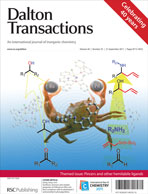This work describes preparation and reaction chemistry of a terminal nickel(II) anilide complex supported by an unsymmetrically substituted diarylamido diphosphine ligand, [N(o-C6H4PPh2)(o-C6H4PiPr2)]− ([Ph-PNP-iPr]−). Treatment of NiCl2(DME) with H[Ph-PNP-iPr] in THF at room temperature produced [Ph-PNP-iPr]NiCl as green crystals in 82% yield. Salt metathesis of [Ph-PNP-iPr]NiCl with LiNHPh(THF) in THF at −35 °C generated cleanly [Ph-PNP-iPr]NiNHPh as a greenish blue solid. The anilide complex deprotonates protic (e.g., PhOH and PhSH) and aprotic (e.g., trimethylsilylacetylene, phenylacetylene, and acetonitrile) acids in benzene at room temperature to give quantitatively [Ph-PNP-iPr]NiX (X = OPh, SPh, C![[triple bond, length as m-dash]](https://www.rsc.org/images/entities/char_e002.gif) CSiMe3, C
CSiMe3, C![[triple bond, length as m-dash]](https://www.rsc.org/images/entities/char_e002.gif) CPh, CH2CN). In addition, [Ph-PNP-iPr]NiNHPh also behaves as a nucleophile to react with acetyl chloride to yield [Ph-PNP-iPr]NiCl and N-phenylacetamide quantitatively. Carbonylation of [Ph-PNP-iPr]NiNHPh with carbon monoxide affords cleanly the carbamoyl derivative [Ph-PNP-iPr]Ni[C(O)NHPh]. The relative bond strengths of Ni–E in [Ph-PNP-iPr]NiEPh (E = NH, O, S, C
CPh, CH2CN). In addition, [Ph-PNP-iPr]NiNHPh also behaves as a nucleophile to react with acetyl chloride to yield [Ph-PNP-iPr]NiCl and N-phenylacetamide quantitatively. Carbonylation of [Ph-PNP-iPr]NiNHPh with carbon monoxide affords cleanly the carbamoyl derivative [Ph-PNP-iPr]Ni[C(O)NHPh]. The relative bond strengths of Ni–E in [Ph-PNP-iPr]NiEPh (E = NH, O, S, C![[triple bond, length as m-dash]](https://www.rsc.org/images/entities/char_e002.gif) C) are assessed and discussed.
C) are assessed and discussed.

You have access to this article
 Please wait while we load your content...
Something went wrong. Try again?
Please wait while we load your content...
Something went wrong. Try again?
![[triple bond, length as m-dash]](https://www.rsc.org/images/entities/char_e002.gif) CSiMe3, C
CSiMe3, C![[triple bond, length as m-dash]](https://www.rsc.org/images/entities/char_e002.gif) CPh, CH2CN). In addition, [Ph-PNP-iPr]NiNHPh also behaves as a nucleophile to react with
CPh, CH2CN). In addition, [Ph-PNP-iPr]NiNHPh also behaves as a nucleophile to react with ![[triple bond, length as m-dash]](https://www.rsc.org/images/entities/char_e002.gif) C) are assessed and discussed.
C) are assessed and discussed.

 Please wait while we load your content...
Please wait while we load your content...